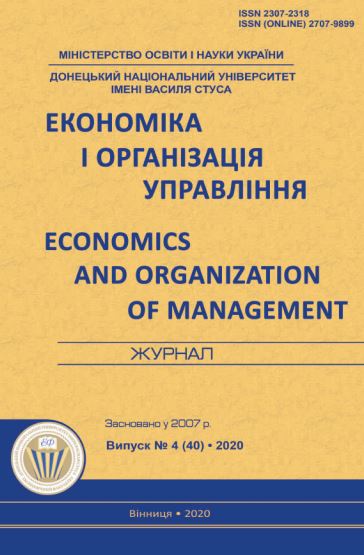Motivation as a leading driving force of activation and activity of the staff of the enterprise
DOI:
https://doi.org/10.31558/2307-2318.2020.4.17Keywords:
motive; motivation; personnel management; motivators; motivational mechanism; staff incentivesAbstract
The article provides a theoretical analysis of the interpretation of the concept of motivation, substantiates its dichotomous nature. The definitions "motive" and "motivator" are revealed. The internal structure of the motive has been systematized and refined, in which four main constituent elements are identified: awareness of the cause of emotional dissatisfaction, awareness of the object / object of satisfying the need, awareness of the way to satisfy the need, and the implementation of the energy component. It has been proved that among the unconscious motives of paramount importance is the attitude, which is considered as a person's integral readiness to perceive future events and implement them in a certain direction. There are three hierarchical levels of regulation of personnel activities, depending on the orientation of the installation: the level of semantic, target and operational settings. The dualistic nature of personnel motivation is revealed, the key point of which is remuneration for work. A scientific and methodological approach to the development of a motivational mechanism for personnel management is proposed, which reflects a holistic representation of the logical chain of actions of a manager aimed at increasing the effectiveness of incentives for personnel and consists of three blocks of management tasks: determining motivators for stimulating personnel, forming motives for personnel activities and identifying motivational expectations of personnel.
References
Левченко Т.І. Мотивація суб’єкта в різних видах діяльності монографія / Т.І.Левченко - Вінниця : Нова книга, 2011. – 448 с.
Коваленко Н.Д. Аналіз людського капіталу підприємства як ключової компетенції / Н.Д. Коваленко, А.П. Должикова // Економічний простір - №75 – 2013 – С. 191-199.
Гуцан О. М. Дослідження сутності мотиваційних теорій: сучасні, теорії атрибуції та поля / О. М.Гуцан // Вісник Національного технічного університету « Харківський політехнічний інститут». – 2017. – № 24(1246). – С.26-30.
Донець Л. І. Мотивація праці як чинник інноваційного розвитку підприємства / Л. І.Донець // Інноваційна економіка. – 2013. – № 4(42). – С.158-161.
Калинеченко А.В. Мотивація та мотиваційний процес: сутність та поняття / А.В. Калиниченко // Вісник економіки транспорту і промисловості. – 2013. – № 42. – С. 417–420.
Проданова Л.В. Мотиваційний механізм розвитку підприємницької діяльності в економіці України: монографія / Л. В. Проданова, О. В. Котляревський; Черкаський державний технологічний університет. – Черкаси. : Видавець Пономаренко Р.В., 2018. – 240 с.
Минков Е. Г. Мотивация. Структура и функционирование – М. : Феникс+, 2014. – 416 c.
Тюхтій М.П. Поєднання мотиваційних аспектів та матеріального стимулювання праці персоналу промислового підприємства / М.П.Тюхтій, В.І.Бережний // Економічний вісник Запорізької державної інженерної академії. – 2016. – Вип. 4-2 (04). – С.47-50.
Співак В.В. Мотивація як засіб ефективного менеджменту персоналу підприємств / В.В.Співак // Вісник Хмельницького національного університету. – 2010. – № 6. – T. 2. – С.178-181.
Узнадзе, Д. Н. Теория установки / Д. Н. Узнадзе. – [Електронний ресурс]. – Режим доступу : http://psylib.org.ua/books/psiteol/txt41.htm

